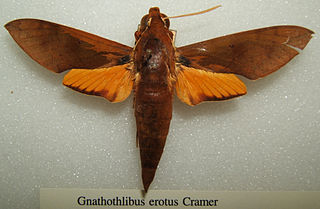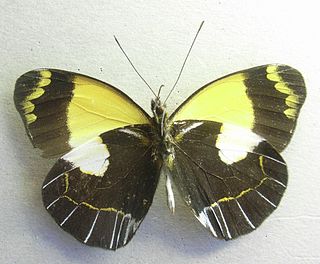Albert Stewart Meek was an English bird collector and naturalist.

Deer Lake First Nation is an Oji-Cree First Nation band government in Northern Ontario, located north of Red Lake, Ontario, Canada. It is one of the few First Nations in Ontario to have signed Treaty 5. It is part of the Keewaytinook Okimakanak Council and the Nishnawbe Aski Nation. As of December, 2007, the First Nation had 1,072 registered members, of which their on-reserve population was 868.
The Manus boobook is a small owl. It has an unmarked brown facial disk, rufous crown and back, barred white flight feathers and tail, and whitish underparts with rufous streaking.

Flexicalymene is a genus of trilobites of the order Phacopida, suborder Calymenina. They are found abundantly in North America. Flexicalymene specimens can be mistaken for Calymene, Gravicalymene, Diacalymene and a few other Calymenina genera. They are used as an index fossil in the Ordovician. Ohio and North America are particularly known for being rich with Flexicalymene fossils. Species include F. meeki and F. retrorsa, F. granulosa, F. senaria and F. croneisi (Ontario).
The Meek's lorikeet is a species of parrot in the family Psittaculidae. It is found on Bougainville Island in Papua New Guinea and the Solomon Islands. Its natural habitats are subtropical or tropical moist lowland forest and subtropical or tropical moist montane forest. It is threatened by habitat loss.
Meek's pygmy parrot, also known as the yellow-breasted pigmy parrot, is a species of small parrot in the family Psittacidae. It is endemic to Papua New Guinea.
The Bougainville crow is a species of bird in the crow family, Corvidae.
The Tagula white-eye or white-throated white-eye is a species of bird in the family Zosteropidae. It is endemic to Papua New Guinea.

The Meek's graphium is a species of butterfly in the family Papilionidae. It is found in Papua New Guinea and the Solomon Islands.
Priacanthus meeki is a red fish found in the Hawaiian and Midway Islands. It grows to a size of 33 cm in length. Common names are Hawaiian bigeye in English and ula lau au in the Hawaiian language. It and other species of its family may also be called āweoweo in Hawaii.

Lake Zirahuén is a small endorheic lake in the municipality of Santa Clara del Cobre in Michoacán, Mexico. It is a deep mountain lake with a sandy bottom that is partially covered with mud. It covers an area of 970 hectares and has a volume of 0.216 cubic kilometres (0.052 cu mi).

Gnathothlibus is a genus of moths in the family Sphingidae.
Allotoca meeki, commonly known as the Zirahuen allotica or the tiro de Zirahuén, is a species of fish endemic to Lake Zirahuén, a small endorheic mountain lake in Michoacán state of central Mexico.

Ambulyx meeki is a species of moth of the family Sphingidae. It is known from the Solomon Islands.

Cincinnetina is an extinct genus of brachiopods which existed in what is now the United States during the Late Ordovician. It was described by Jisuo Jin in 2012, as a new genus for the Orthis species O. multisecta and O. meeki, each of which have been replaced a number of times under other genera, e.g. Dalmanella, Resserella, and Onniella by other authors. A third species, C. minnesotensis, was described from Minnesota, from which its species epithet was derived.

The American halfbeak is a halfbeak from the Hemiramphidae family.

Delias meeki is a butterfly from the family Pieridae. It occurs in seven subspecies in West Papua and Papua. The specific name commemorates English naturalist Albert Stewart Meek who collected the type series in May 1903 at Owgarra north of head of the Aroa River in Papua New Guinea. It forms a species group with the sympatric species Delias niepelti
Chrysasura meeki is a moth of the family Erebidae. It is found in New Guinea.

Sybra is a genus of beetles in the family Cerambycidae, containing the following species:

Sybra ordinata is a species of beetle in the family Cerambycidae. It was described by Bates in 1873.












